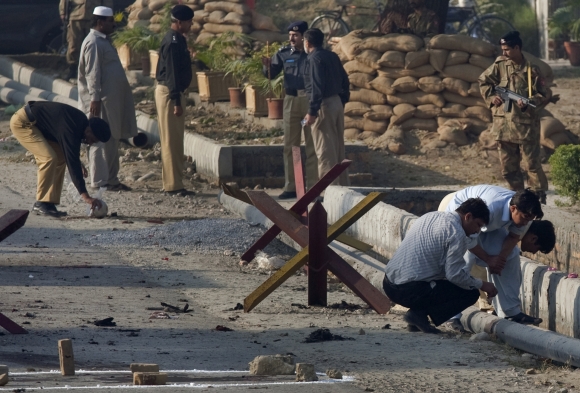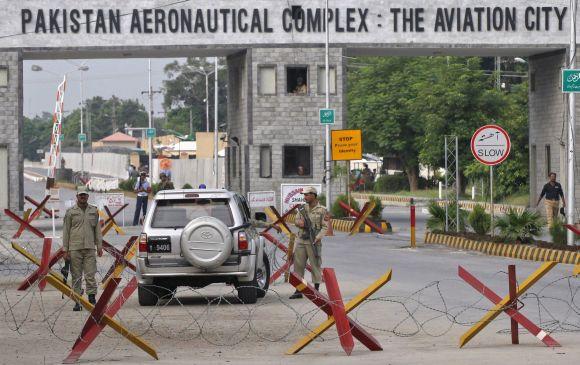
The Pakistani Army's game plan of promoting Islamic militant groups to counter perceived threats has unleashed a Frankenstein that will be extremely difficult to be tamed.
The recent attack in Karachi airport and subsequent Pakistan Army operation against militants in North Waziristan has once again brought to focus the tinderbox that is Pakistan and the militant Islamic groups operating there in general, and the Tehrik-e-Taliban in particular.
What is it that Pakistan is facing today? What is the extent of threat to Pakistan and to the region from the group known as Tehrik-e-Taliban Pakistan?
TTP's origins are linked to the Afghan developments after the defeat of the Taliban there in 2001-2002. After the Taliban were defeated by the US Army aided by Afghan groups, they started hunting down different Islamic militant groups that were operating out of Afghanistan. Most of these groups and militant leaders sought refuge in the semi autonomous regions along the Pak-Afghan border known as Federally Administered Tribal Areas of Pakistan.
These areas had traditionally been governed by local tribal leaders based on their social code of conduct and since British period have had very little direct control by any federal or provincial government. Once the Pakistani government under General Musharraf decided to support the US war efforts in Afghanistan, the Pakistan Army was called upon to flush out the elements of Afghan Taliban as well as foreign fighters who had taken refuge in FATA.
...

The Pakistan Army actions were considered an infringement of their autonomy by the local tribes who always considered themselves only loosely linked with Pakistan and were governed by a separate set of laws from those in "settled" parts of Pakistani province of North West Frontier Province. Many of the local tribal leaders were supporters of the Afghan Taliban and were wooed by them as well by other foreign militant groups who were earlier operating out of Afghanistan. These included Al Qaeda and Islamic Movement of Uzbekistan to name the two most important groups.
The then Pakistani government saw the issue only from a military viewpoint and rather than trying to win support of local tribes against these foreign militants decided to flush out the militants by strong-arm methods. In the process the local tribes rose in revolt. However, for a long period the resistance to Pak Army was local and tribe based. As a result local militias sprang up everywhere in FATA to fight the Pakistan Army.
While these militias were not part of Afghan Taliban or Al Qaeda, most of them were sympathisers of Afghan Taliban, since ethnically they were both Pashtuns and Afghan Taliban had projected themselves as fighting for Pashtuns of Afghanistan against the Tajik dominated Northern Alliance in Afghanistan. The local FATA tribal leaders had also got substantial financial assistance from Al Qaeda and other militant groups to allow them to remain in FATA. Therefore, generally these Pakistani militia groups were allied with Afghan Taliban and they called themselves Pakistani Taliban.
It was in December 2007 that a Shura of 40 senior Pakistani Taliban leaders decided to establish an umbrella organisation and called it Tehrik-e-Taliban Pakistan. They chose Behtullah Mehsud of Mehsud tribe as their Amir, Hafiz Gul Bahadur of North Waziristan as senior Naib Amir and Faqir Mohammad of Bajaur as the 3rd in command. The Shura had representations not only from all of FATA's 7 tribal agencies, but also from districts of settled areas of then NWFP such as Swat, Bannu, Tank, Lakki Marwat, Dera Ismail Khan, Kohistan, Buner and Malakand.
Thus, it tried to and got support from a wide cross section of tribal leadership of the area. In the period between 2002 and 2007 another related development took place that was not taken seriously at the time by the Pakistani government which was engaged only in military action in the area. That was marginalisation of the local tribal leaders by the militant groups. The traditional tribal leaders of the area were elbowed out by force by the younger and financially more powerful militant leaders who were supported by Al Qaeda and Afghan Taliban.
...

Although TTP was formed in December 2007, it has never grown into a unified group. By its very nature it continues to be conglomeration of different militant tribal groups that broadly follow similar goals. The strife within TTP is thus natural and Pakistani Army has tried to take advantage of this fact consistently though it must be conceded not very successfully. The Army has developed some relationship with leaders such as Hafiz Gul Bahadur with whom their "cease fire" continues off and on.
Given its ideology and its origin, the TTP has developed extensive contacts with other Islamic militant groups operating in Pakistan. Some of these groups such as Lashkar-e-Zil, 313 Brigade and Harkut-ul-jihad-e-Islami have at different points announced their merger with TTP. With others such as Lashkar-e-Jhangvi and Sipah-e-Sahaba TTP works in close concert particularly in targeting Shias. Their relationship with the ISI sponsored groups such as Lashkar-e-Toiba, Jaish-e-Mohammad and the Haqqani network across Afghan border however is more complex.
Because of obvious reasons there are no public pronouncements by these militant groups of working along with TTP but there are enough indications to suggest that they have developed tactical relationship. Given the overlapping membership of Islamic groups in Pakistan this is inevitable. It however needs to be emphasised that with the leaders of the ISI sponsored groups such as LeT, TTP does not enjoy same warmth as it does with other militant Islamic groups.
...

Before the recent Pakistani Army attack in North Waziristan, there had been many attempts both by the Pakistani army as well as by the political parties to initiate a peace dialogue with the TTP. There was however difference between the two approaches. The Army had right from the beginning only wanted to split the TTP and support those factions which it was able to win over to take on the other recalcitrant factions. The Army leadership always felt that the militant Islamists are a card they could use against India as well as against their local political opponents and though TTP leadership was against them they could handle them by creating splits within the group.
Among the political parties some such as Muttahida Qaumi Movement and Pakistan Peoples Party have been staunchly opposed to all shades of Islamic militants and therefore their opposition to TTP is obvious. The Islamic parties such as Jamaat-e-Islami, various factions of JUI and Pakistan Tehreek-e-Insaf, which is taking a more Islamic position than even Islamists, have been for equally obvious reason opponents of any military action against the TTP and have been advocating a dialogue with the TTP.
Nawaz Sharif's position has been one of holding a middle ground. On his coming to power he has tried to initiate a dialogue with the TTP but by now it is clear the effort has failed. It was in any case doomed to failure because he did not have Army's support for the move and the demands of TTP are such that no peace deal was possible without active Army support which was lacking.
The TTP's stated goal is to replace the Pakistani government with one that functions according to its interpretation of Islamic Law. It is obvious that this cannot be accepted by any mainstream Pakistani politician. However it is understood that the TTP could have been persuaded to give up this demand if the Pakistani government agreed to release of hundreds of its members who are in jail and agree to the withdrawal of Army from Waziristan.
Neither Nawaz Sharif nor any political party in Pakistan is in position to agree to these demands as it falls within the Army's domain and the Army was not agreeable to these demands. The talks were therefore destined to fail. Now that this has happened, what next?
...

To assess whether the current offensive by Pak army will succeed or not it is important to first find out what the objectives of the Army are. If the objective is to "pacify" the FATA area by extensive bombing, it is possible that the Army may succeed if it has the willpower to see the operation through. But will that solve the problem being faced by Pakistan because of Islamic militants? The answer is an unequivocal "No".
The Pakistani Army has undertaken similar operations at different times in North and South Waziristan and in Swat. None of those offensives were successful in the long run though the Pakistani Army did claim victory at different times. Most of the times and particularly this time, such offensives have been anticipated and planned for by the TTP leadership. Now with a virtually open Pak Afghan border and dwindling US Army presence in Afghanistan, more important leaders of the TTP can easily cross into Afghanistan and being of same ethnicity easily merge with local population.
With the support that they enjoy in Afghanistan this is an obvious advantage. In addition the number of TTP cadres living in Karachi and other parts of Pakistan may now run into hundred of thousands.
These are not affected by the Army operation in Waziristan. In any case, as a matter of principle, aerial bombing of the civilians in your own country will by very nature create more supporters for the target groups and alienate the local population further creating situation for a more sustained insurgency to develop. That is the result that can be foreseen in Waziristan too. Since free flow of the population from Waziristan and even from Afghanistan to other areas of Pakistan is uncontrollable, it will mean more and more terrorist type attacks by TTP and its supporters in Pakistan.
So what is the likely scenario for Pakistan? Unfortunately, there does not seem to be a peaceful solution to the issue in the near future. The Pakistani Army's game plan of promoting Islamic militant groups to counter perceived threats to them from the unfriendly political parties domestically, and from India and Afghanistan externally, has unleashed a Frankenstein that will be extremely difficult to be tamed.
If only the Pakistani Army realised even now that riding a tiger is a dangerous proposition and take corrective actions the problem can perhaps be tackled even though it will take a long time. If not, Islamic militant groups led by TTP will become an existential threat to Pakistan as we know today.
Rajiv Kumar, retired as Additional Secretary in Cabinet Secretariat, Government of India.